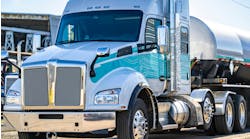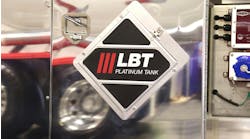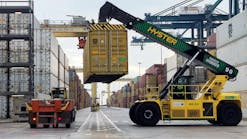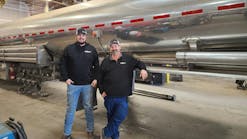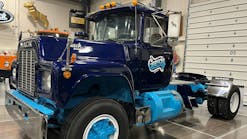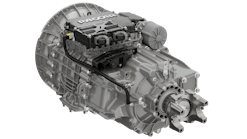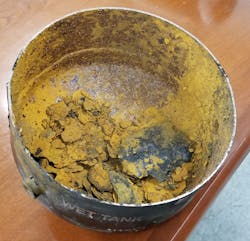Why is it important to ensure a clean, consistent path for compressed air to take from the compressor to trailer components, which include brakes, automatic tire inflations systems, and air ride systems?
For Richard LaFlamme, technical services manager at SAF-Holland, the answer is simple: failure to do so impacts carriers and their customers.
“Restricted or contaminated air causes premature component failure,” he said. “The consequence is unwanted and unplanned out-of-service time, which delays deliveries and increases maintenance costs, especially in high duty cycle applications.”
There are other reasons as well.
“The air system uses numerous components to control the brakes, suspensions, and other things,” said Dick Winter, lead senior engineer at Link Mfg. “These valves and solenoids have seals, O-rings, diaphragms, and other moving parts, which work best when you have clean air. If contaminants find their way into the air system, they begin to act on the components, reducing their effectiveness.”
Chris Stadler, product marketing manager for Volvo Trucks North America–VNL, noted that any pneumatic component can be subject to moisture or oil contamination, so careful attention to system health and functionality is necessary for maximum uptime.
“Ensuring the cleanliness of compressed air is more important than ever given the dramatic rise in use of vehicle pneumatic technologies in the past decade,” he added. “Without clean compressed air the risk of expensive repairs and downtime dramatically increases.”
Stu Russoli, senior highway product manager for Mack Trucks, agreed, adding that “pneumatic technologies have become integral to the safe operation of trucks, so delivering consistent, clean compressed air to those systems is extremely important.”
But defining ‘high-quality’ air is difficult because there isn’t an industry standard, related Richard Nagel, director of marketing and customer solutions for air supply and drivetrain at Bendix Commercial Vehicle Systems. “And yet,” he said, “because systems today are more sophisticated than they used to be, they also require a higher quality of air.”
According to Mark Hawkins, head of technical products for Redline Detection, air brake leaks are becoming an even bigger issue for some fleets. Hawkins said some of today’s heavy-duty trucks have characteristics that make them more susceptible to a leak.
Historically, main lines were made of heavy-duty copper with threaded connections. Leaks rarely emerged unless rub-through occurred, Hawkins explained. “Fleets never really had a problem because everything had a good, heavy-duty connection, and everything was still threaded between parts,” he said.
Today, this is not always the case. There are large bundles of air lines because air is being supplied not only to the brakes, but also to the suspension and the cab, among other areas of the vehicle. “Things just aren’t as robust as they used to be,” Hawkins related.
What happens when air is not clean?
If air systems are not maintained properly, they may not operate correctly or could fail completely. In the case of brakes, components could freeze up or fail prematurely, Russoli noted. For a suspension, loss of ride quality is likely as well as the inability for the suspension to be raised or lowered, which results in a loss of critical capabilities.
“Excessive moisture in compressed air has caused steel air tanks to corrode internally, which creates particulates in the air lines that can damage the systems that use the air,” Russoli continued. “That’s especially true for transmission control systems, and is important considering the increased use of automated manual transmissions that rely on compressed air to operate.”
Braking system modulators and wheel-end pneumatic components can freeze with excessive moisture or fail prematurely from chemical incompatibilities with oil contaminants, Stadler noted. “When this occurs, contaminants will accumulate inside valves and O-rings, causing corrosion, clogging, or internal valve damage,” he explained. “Any internal damage or freezing in braking components could cause sudden loss of [anti-lock brake system] functionality or more advanced braking or traction control functions.
“Suspension control system components can be subjected to the same failure modes,” Stadler continued. “Any internal damage or freezing could cause the sudden inability to lower the suspension to pick up or drop off a trailer. In rare cases, if enough moisture has accumulated in the air bags, it can affect load leveling controls and optimization for dynamic control, resulting in loss of productivity for load sensing adjustment and driver comfort.”
Stadler pointed out that prolonged excessive moisture causing internal corrosion of steel air tanks is of particular concern because the corrosion creates additional particulates that are subsequently sent through to downstream systems.
“When more moisture is introduced, the rust particulates coagulate or congeal, causing devasting effects and often sudden, complete failure,” Stadler said. “This type of failure has typically targeted the air compressor governor, given its proximity to the air tanks and small internal mechanical components that can easily be compromised. Any pneumatic component can be subject to moisture or oil contamination, resulting in a challenging diagnostic process to uncover the issue.”
Additionally, Stadler noted that transmission and emission systems utilizing vehicle air have been subject to sudden failures. Transmission control systems, like those with air-assisted clutch actuation or overdrive assist, have been victim to contaminated compressed air. Damage to pneumatic components within the emissions system are often undetectable, he added, but have caused problems to downstream emissions components and impacted processes.
Joe Kay, director of engineering at Cummins-Meritor, pointed out that there can be negative consequences if water or particles get inside suspension air bags. “Any ingress can have longterm affects such as non-functioning valves, internal corrosion, etc.,” he said.
LaFlamme related three areas of air system contamination concern. One is when oil from the compressor becomes hot enough to congest the discharge line with carbon, restricting airflow. “The heat from this restriction expands the air molecules, slowing system air pressure regeneration,” he said. “Excessive oil will also corrupt the desiccant properties in the air dryer filter.
“Another issue can be when high water content freezes in the air system, preventing proper system operation,” LaFlamme continued. “Excessive water reduces the actual air volume, reducing functionality. Impurities in water, like minerals, can cause springs inside the valves to decay, eventually causing the valve to malfunction and leading to failure. Water impurities can also cause combination-style brake actuator center seals to pass air from the parking chamber to the service chamber.”
The third concern is alcohol. For example, when alkyl-grouped molecules modify polymer and elastomer components, like O-ring seals, this will eventually cause them to malfunction.
If contaminants are somehow introduced into the air system, Winter reported, they can increase friction within valves. “Valves obviously have moving parts, and contaminants can begin to hinder their movement, so they begin to develop operational limitations and extra resistance to smooth component motion,” he explained. “You can also get air leaks if the contamination gets on seals and compromises them. Once that happens, the seals no longer mate up properly and you can have a leak path through any gaps.
“Contaminants can also reduce your overall airflow in the system, and this alone can cause problems,” Winter continued. “They can also cause accelerated component wear within the valves. Especially when you’re dealing with a contaminant like oil, it can begin to coat surfaces and valves and then, if you’re trying to run an O-ring over it, that can accelerate wear.”
Depending on the type of contaminant, the system might be exposed to a chemical attack on the rubber components within the valve as well, Winter pointed out. “Even a substance as seemingly benign as water can get trapped in the wrong place and can freeze, which will prevent a valve from moving properly,” he said. “You could also have water accumulation in an air line and if it freezes, you’ve got a plugged system.”
Best practices: Suggestions from suppliers
- Ensure the engine air filter is clean
- Replace the air compressor (and discharge pipe) if it pumps excessive oil into the air system
- Drain reservoirs daily
- Follow PM instructions for air dryers
- Avoid inducing alcohol and lubricants into the air system
- Seal gladhand connections when equipment is decoupled
- Confirm that air dryers are operating properly and change cartridges on time
- Regularly drain the air tanks. If oil or excessive water is present, it may be an indication that you need to address quickly
- Train drivers to monitor the frequency of their compressor turning on and off or when the dryer purges; if too often, that may be an indication of a leak
- Never put additives into an air system. They can remove lubricants and collect in valves, negatively affecting rubber seals
- Check air lines for sections where water could freeze.
Redline Detection offers a unique piece of shop and service equipment to help technicians locate air system leaks in a matter of minutes. The Air Brake NanoLeak Finder is a heavy-duty diagnostic leak detector that diagnoses high-pressure air brake, air suspension, and air-powered systems. The detector, used in conjunction with the included NanoLeak Handheld Leak Locator, locates all air brake and air-powered system leaks.
Choosing the right compressor for service trucks
Making the right choice for mounted compressors is important, noted manufacturer Vanair. Two of the most popular types of air compressors are rotary screw and reciprocating (or piston) models.
A rotary screw air compressor is oil-flooded. The oil inside the unit acts as a lubricant, seals the rotors, and cools the system from the heat of compression. Key benefits to using a rotary screw compressor include fewer moving parts and less maintenance.
A reciprocating air compressor works by using pistons driven by a crankshaft to compress the air. These compressors, which require an auxiliary tank for air storage, are best suited for intermittent use, such as on service and tire trucks.
In the end, choosing a rotary screw or reciprocating air compressor comes down to application and desired lifespan.
This story originally appeared on FleetMaintenance.com.
